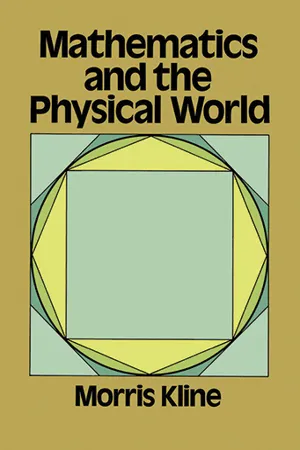Physics
Projectile Motion
Projectile motion refers to the curved path an object follows when it is thrown or launched into the air. It is influenced by both horizontal and vertical components of motion, with the horizontal component remaining constant and the vertical component being affected by gravity. The motion can be analyzed using equations of motion and is a fundamental concept in physics.
Written by Perlego with AI-assistance
Related key terms
9 Key excerpts on "Projectile Motion"
- eBook - ePub
Introductory Physics
Summaries, Examples, and Practice Problems
- Michael Antosh(Author)
- 2023(Publication Date)
- CRC Press(Publisher)
gravity is the only force that is acting significantly on the object.Gravity is a force that pulls objects towards each other. For an object near Earth, that means that the object is pulled downward, towards Earth. We will talk about gravity in more depth in Chapter 4 .Everything is the same as Section 3.5 immediately before this, with one extra piece of information:If we define the x direction as “the direction that the object is moving horizontally” and the y direction as “upward”, the acceleration in Projectile Motion is alwaysa = 0 i – 9.80 m/s2 j(3.6.1)The number 9.80 m/s2 is the same “acceleration due to gravity” mentioned with free fall in Section 2.7. Since we defined upward as the positive y direction, it is negative.Here are some tips for solving Projectile Motion problems:- In Projectile Motion problems, it’s very common for the initial velocity to be given as a magnitude and angle, instead of as components. You can use Equations 3.3.4 and 3.3.5 to find the components:
(x component magnitude) = (magnitude) · cos(angle)(3.3.4)(y component magnitude) = (magnitude) · sin(angle)(3.3.5)Don’t forget to assign plus and minus signs yourself when using these equations.- It will often be useful to solve for the time it takes for an object to hit the ground, using the y-dimension, and then use that amount of time in the x-direction equations. Remember that time is always the same in both the x and y equations.
- eBook - ePub
- Hiqmet Kamberaj(Author)
- 2021(Publication Date)
- De Gruyter(Publisher)
the x, y and z axes. 4.3 Projectile Motion We often have observed a baseball in motion or any other object thrown into the air, such as an arrow shown in Fig. 4.5. By definition, this kind of movement is called Projectile Motion. Figure 4.5 An example of the Projectile Motion. v total represents the total velocity at any point of the Projectile Motion; v x and v y are, respectively, the x and y components. α is the angle formed by the direction of v total and x -direction, which varies from point to point along the trajectory. Assumptions of Projectile Motion In this motion, the ball follows a curved path, and its motion is simple to analyze if we make two assumptions: 1. The free-fall acceleration g is constant over the range of motion and is directed downward. 2. The effect of air resistance is negligible. Taking into account these assumptions, we will find in the following that the Projectile Motion’s path of a projectile (or the trajectory) is always a parabola. To show this, we consider the Projectile Motion in a reference frame such that the y -axis is vertical, and its positive direction is upward. Since the air resistance is neglected, we know that a y = − g (as in one-dimensional free fall) and that a x = 0. Also, the projectile is initially (t = 0) positioned at the origin (x i = y i = 0) with velocity v i, as shown in Fig. 4.6. The vector v i makes an angle θ i with the horizontal, where θ i is the initial angle (at the origin) between the direction of v i vector and the x -direction. Figure 4.6 Projectile Motion of the baseball. From the definitions of the cosine and sinus functions, we obtain the x and y components of the initial velocity: (4.29) v x i = v i cos θ i v y i = v i sin θ i. Substituting the x component from eq. (4.29) into eq. (4.25) and taking x i = 0, a x = 0, we - No longer available |Learn more
MCAT Physics and Math Review 2024-2025
Online + Book
- (Author)
- 2023(Publication Date)
- Kaplan Test Prep(Publisher)
x-direction, one can find the horizontal distance traveled.Projectile Motion
Projectile Motion is motion that follows a path along two dimensions. The velocities and accelerations in the two directions (usually horizontal and vertical) are independent of each other and must, accordingly, be analyzed separately. Objects in Projectile Motion on Earth, such as cannonballs, baseballs, or footballs, experience the force and acceleration of gravity only in the vertical direction (along the y-axis). This means that vywill change at the rate of g but vxwill remain constant. In fact, on the MCAT, you will generally be able to assume that the horizontal velocity, vx, will be constant because we usually assume that air resistance is negligible and, therefore, no measurable force is acting along the x-axis.KEY CONCEPT
Note that gravity is set in bold, indicating it has a vector value. Gravity is unique in that it is used as both a constant and as a vector in calculations. Though gravity is not always bolded, you should recall for Test Day that gravity has a direction.Example:A projectile is fired from ground level with an initial velocity of50and an initial angle of elevation of 37°, as shown below. Assumingm sg = – 10find the following: (Note: sin 37° = 0.6; cos 37° = 0.8)m,s 2- The projectile’s total time in flight
- The total horizontal distance traveled
Solution:- Let y equal the vertical displacement, and up be the positive direction. If we are going to use the vertical displacement and acceleration due to gravity (which is also in the y-direction), we must use the y-component of velocity in this part of the problem:
Now we can plug in:v=0 yv 0sin 37 ° =(( 0.6 ) = 3050)m sm sy =The height of the ball is zero at 0 seconds (its initial position) and 6 seconds (when it hits the ground again).t +v 0y0 =2a yt 230t +m s0 = 30 t - 52–10ms 2t 2t 25t 2= 30 tt 2= 6 t t = 0 s or 6 s
- eBook - ePub
Sports Biomechanics
The Basics: Optimising Human Performance
- Prof. Anthony J. Blazevich(Author)
- 2017(Publication Date)
- Bloomsbury Sport(Publisher)
CHAPTER 3 Projectile MotionBy the end of this chapter you should be able to:What is the optimum angle of trajectory or flight path (that is, the angle thrown relative to the ground) for a shot-putter aiming to throw the maximum distance? (Hint: not 45°.) What factors affect maximum throwing distance and to what degree?• List the factors that influence an object’s trajectory• Use the equations of Projectile Motion to calculate flight times, ranges and projection angles of projectiles• Design a simple model to determine the influence of factors affecting projection range• Create a spreadsheet to speed up calculations to optimise athletic throwing performance• Complete a video analysis of a throw to optimise performanceProjectile Motion refers to the motion of an object (for example a shot, ball or human body) projected at an angle into the air. Gravity and air resistance affect such objects, although in many cases air resistance is considered to be so small that it can be disregarded. A projected object can move at any angle between horizontal (0°) and vertical (90°) but gravity only acts on bodies moving with some vertical motion.Trajectory is influenced by the projection speed, the projection angle and the relative height of projection (that is, the vertical distance between the landing and release points; for example, in a baseball throw that lands on the ground, the vertical distance is the height above the ground from which the ball was released).FIG. 3.1 Tennis ball trajectory. Gravity accelerates the ball towards the ground at the same rate regardless of whether the tennis player leaves the ball to fall freely or hits it perfectly horizontally. However, the trajectory of the ball is different in these two circumstances.Projection speedThe distance a projectile covers, its range, is chiefly influenced by its projection speed. The faster the projection speed, the further the object will go. If an object is thrown through the air, the distance it travels before hitting the ground (its range) will be a function of horizontal velocity and flight time (that is, velocity × time, as you saw in Chapter 1 ). In Figure 3.1 - eBook - ePub
Doing Physics with Scientific Notebook
A Problem Solving Approach
- Joseph Gallant(Author)
- 2012(Publication Date)
- Wiley(Publisher)
Chapter 4Projectile Motion
The 1-dimensional kinematics of Chapter 2 allow us to describe horizontal or vertical motion in a straight line. Vectors allow us to analyze 2-dimensional objects. Now we combine the two and use vectors to describe 2-dimensional motion. A 2-d kinematics problem is really two 1-d kinematics problems and we use vectors to break the analysis into components.One example of 2-d motion is Projectile Motion, where an object is launched with an initial velocity and then is influenced only by gravity and air resistance. The object’s initial coordinates are x0 and y0 . Its initial velocity has magnitude v0 and direction θ0 above the horizontal.The horizontal component of the initial velocity is vox = v0 cos θ0 and the vertical component is voy = v0 sin θ0 . This unusual notation is due to a limitation of SNB: the engine can’t handle a double subscript unless the indices are either both numbers or both letters. So we’ll use vox instead of vox and voy instead of v0y. Here is a summary of the notation for the velocity and position of our projectile.Table 4.1With the equations of 1-dimensional kinematics and vectors, we can analyze Projectile Motion with and without air resistance. We will calculate the horizontal position x and the height y as functions of time directly and separately, and calculate the trajectory, the mathematical description of the path of the projectile that gives the projectile’s height as a function of horizontal position. We will also calculate how far the projectile travels horizontally before landing, how much time it spends in the air, and its maximum height.No Air Resistance
In the absence of air resistance, the only influence on the projectile is gravity. Near the Earth’s surface, the acceleration due to gravity is constant so we can use Eqs. (2.5) and (2.6) - eBook - ePub
- Morris Kline(Author)
- 2013(Publication Date)
- Dover Publications(Publisher)
2 , the first law of motion, and the independence of the horizontal and vertical motions, permits us to deduce a vast amount of knowledge about our physical world. The knowledge referred to at the moment concerns Projectile Motion under idealized conditions; that is, the resistance of air is neglected; the earth is assumed to be flat over the short distances which the projectiles cover; and the projectiles are limited to travel near the surface of the earth. One might regard the whole story as of minor interest because it deals with just one phenomenon and one which seems limited to bombs and guns. However, the study of this phenomenon has proved to be of immeasurable scientific importance. First of all, the deductions made from the physical axioms mentioned above can be checked experimentally. If the deductions agree with experience we have some reason to believe that the axioms are correct. We must remember in this connection that physical axioms are generalizations from limited experience and that our confidence in them depends upon how well they continue to lead to new physical facts. Secondly, the study of motions near the surface of the earth, Projectile Motion in particular, led to the most important advance in science since 1600, namely Newtonian mechanics. The step to the broad science of mathematical mechanics will be taken in the next chapter.REVIEW EXERCISES
1. Sketch the curves whose parametric equations are given below.a) x = 3t , y = 7tb) x = 3t , y = 5t 2c) x = 3t 2 , y = 5td) x = 3t + 7, y = 5t + 9e) x = 5 cos θ, y = 5 sin θf) x = 2t , y = 5 t 2 + 3t2. Find the direct equations in parts (a), (b), (c), and (d) of Exercise 1. 3. Suppose a bomb is released from an airplane which is flying horizontally at a speed of 240 mph.a) Write the parametric equations of motion of the bomb.b) If the airplane is one mile above the ground, how long will it take the bomb to strike the ground?c) Suppose the airplane flies at 300 mph instead of 240. How long will it take the bomb to strike the ground? - Paul Grimshaw, Neil Fowler, Adrian Lees, Adrian Burden(Authors)
- 2007(Publication Date)
- Routledge(Publisher)
Fig. B5.5.ConsideringFig. B5.5in terms of the vertical component of the ball’s motion, we can see that it travels upward and downward (displacement/time graph;Fig. B5.5: graph 1) with a decreasing vertical velocity (positive value) as it travels upward. The ball then reaches the peak height of the flight path and the velocity changes direction (i.e., it stops going upward and instantly starts coming downward) and throughout this action it has been accelerating at a constant rate (–9.81 m/s2 ) with a decreasing positive vertical velocity and an increasing negative vertical velocity (graphs 2 and 3). This is exactly the same as when the ball that was thrown perfectly vertically (providing the vertical release velocity was the same in both experiments). Horizontally, the ball will be displaced as shownFig. B5.5: graph 4. It will travel forwards with constant horizontal velocity (graph 5) in accordance with Newton’s first law and it will do so with zero horizontal acceleration (constant velocity horizontally as in graphs 5 and 6). Hence, vertical and horizontal motions during projectile flight are independent of each other and gravity affects the vertical component only.Fig. B5.5. The graphical representation of the motion of a ball thrown with vertical and horizontal velocityAir resistance
In the understanding of vertical projection it is worth making a comment about the effects of air resistance. Normally, in human motion we consider the effects of air resistance to be negligible (particularly on the human body as it travels as a projectile through the air). However, in certain applications the effects of air resistance will not be negligible and will be considered as an external force that affects motion. For example, in the case of dropping objects vertically, we know from Newton’s law of gravitation that any object near to or on its surface regardless of its mass will accelerate toward the ground at a constant rate (i.e., two objects of different masses when dropped at the same height will both hit the ground at the same time). However, if you take the case of dropping a piece of paper and a golf ball you will see that the golf ball will hit the ground first. In this case air resistance will affect the piece of paper by a significant amount such that its descent towards the Earth will be slowed down (air resistance becomes an external force). Similarly, in sports such as javelin, hammer throwing, and discus, and even to an extent in long jumping when there are “head and tail” winds air resistance will have an effect. Often long jumps that are wind assisted are not legitimate jumps (in this case the tail wind would be an external force of assistance). Hence, in certain sports and movements it may be the case that the air resistance effects should be considered to be more than negligible. Experiment with dropping different objects from the same height to see if you can demonstrate the effects of air resistance on the vertical downward acceleration of objects caused by the force of gravity- eBook - ePub
- Morris Kline(Author)
- 2012(Publication Date)
- Dover Publications(Publisher)
x in the horizontal direction is(6)Since this velocity is constant, the horizontal distance x traveled in time t is(7)The vertical motion is slightly more complicated. If there were no gravitational force pulling the projectile downward, it would continue to travel upward at the constant velocity V sin A . However, as the projectile rises gravity pulls it down. Now we saw in chapter 12 that any object subject to the action of gravity will have an acceleration in the downward direction of 32 feet per second each second and will therefore acquire a downward velocity of 32t feet in t seconds. Hence the first statement we may make about the vertical velocity of the projectile is that its net velocity v y at any time t is(8)How far above the ground will the projectile be any time t? Well, the velocity V sin A will cause the projectile to rise Vt sin A feet in t seconds. During these t seconds the action of gravity will pull the projectile downward 16t 2 feet. Hence the net vertical distance y attained by the projectile in t seconds is(9)In deriving formulas (8) and (9) we have assumed that the motions of rising and falling may be considered separately, even though they take place simultaneously. But each motion is due to a separate and independent force, just as the horizontal and vertical motions are independent, and, consequently, our derivation rests on a sound physical principle.Formulas (7) and (9) describe the separate motions in the horizontal and vertical directions, each giving a distance in terms of time t . For any given time t we could calculate x and y and thus know where the projectile is at that time. However, we might like to know what the actual path of the projectile is without having to calculate successive x and y - eBook - ePub
Sports Math
An Introductory Course in the Mathematics of Sports Science and Sports Analytics
- Roland B. Minton(Author)
- 2016(Publication Date)
- Chapman and Hall/CRC(Publisher)
Chapter 1Projectile Motion
Introduction
Basketball star Stephen Curry launches a 3-point shot. As the ball traces its high arc toward the basket, fans rise to their feet in anticipation. Will it go in? Is it a little short? Similar tension accompanies a Jordan Spieth tee shot, an Andy Murray passing shot, a long football pass by Peyton Manning or Lionel Messi, or a long fly ball by Mike Trout. We will analyze the flights of balls in this chapter as we explore the area of physics known as mechanics.Along the way, we will answer such questions as: How does Blake Griffin hang in the air when dunking? What is the optimal angle to shoot a free throw? Why do golf balls have dimples? Does a knuckleball really dance? The answers are to be found in the fundamentals of physics.Figuring with Newton
Sir Isaac Newton (1643-1727) constructed a framework for the analysis of objects in motion. The second of his three Laws of Motion is the launching point for most of our investigations in this chapter. The shorthand version of Newton’s Second Law isF = mawhere F is the sum of all forces acting on an object, m is the object’s mass, and a is the acceleration of the object. One of the most remarkable aspects of Newton’s Second Law is that it can also be written as F = m a , where F and a appear in bold to indicate that they are multidimensional vector quantities. We will return to this form of the equation when we look at motion in two and three dimensions. The mass m is a scalar (real number) that is related to weight: for earthbound sports, weight is approximately equal to mass times the gravitational constant g .To keep it simple, let’s start with one-dimensional motion; vertical motion, to be precise. In this case, the object’s position can be tracked by its height h above some reference point (e.g., the ground). We define velocity as the rate of change of position with respect to time. At a constant speed, this means that velocity equals change in height divided by change in time:υ =Δ hΔ t
Index pages curate the most relevant extracts from our library of academic textbooks. They’ve been created using an in-house natural language model (NLM), each adding context and meaning to key research topics.








